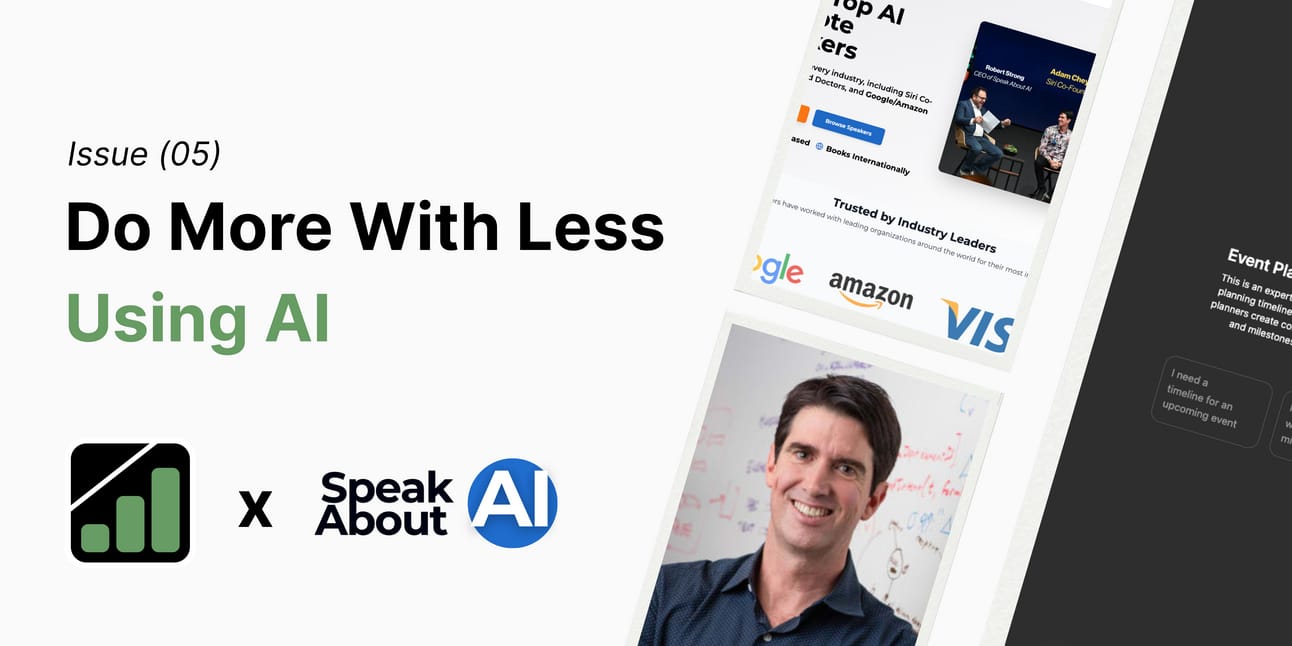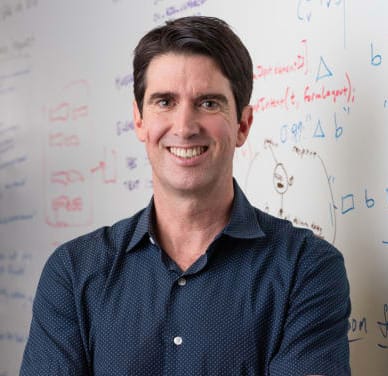- Do More With Less Using AI
- Posts
- Do More With Less Using AI (Issue 05)
Do More With Less Using AI (Issue 05)
In this edition: Timeline Generator 2.0 with enhanced task management, building technical solutions without technical skills, insights on AI's knowing vs. doing gap from Siri co-founder Adam Cheyer, and more event roles.

🌟 Noah’s Note
Welcome to the fifth issue! Hard to believe we've made it this far—there's something special about hitting edition five that feels like a real milestone. This week is particularly exciting because I get to relaunch the Timeline Generator with major updates based on feedback from 700+ users, and spotlight one of my favorite speakers from our roster.
🤖 GPT of the Week: Timeline Generator 2.0
THE PROBLEM: After talking with a Head of Meetings & Events, one major time-suck became crystal clear: building comprehensive timelines that account for ALL the critical deadlines and potential disaster scenarios. You'd spend hours creating what seemed like a solid timeline, only to miss crucial vendor deadlines, underestimate shipping logistics, or get blindsided by venue restrictions you never saw coming.
THE SOLUTION: Timeline Generator 2.0 transforms timeline creation from a guessing game into a systematic process built on industry best practices from PCMA, MPI, and EIC standards. Based on feedback from 700+ event professionals, this relaunch adds the guardrails and consistency that turns good timelines into bulletproof project management systems.
Start by Choosing Your Starting Point:
"I need a timeline for an upcoming event" – Comprehensive timeline creation from scratch with guided setup
"Help me identify what I might be missing" – Audit your existing plan for potential gaps and risks
"I have a template/timeline - can you enhance it" – Optimize your current timeline (copy/paste text for best results)
Next, it Gathers Information:
Smart Diagnostic Process: Progressive questions that adjust based on your event type and complexity
Risk Assessment: Identifies potential failure points before they become problems
Dependency Mapping: Shows how delays in one area cascade to others
Improved Output Options:
Executive Overview: High-level milestones and critical decision points
Comprehensive Timeline: Detailed task breakdown with dependencies and buffer times
Risk-Focused Timeline: Critical path highlighted with contingency triggers
KEY IMPROVEMENTS:
Three Clear Conversation Starters: No more blank page syndrome—guided entry points for different scenarios
Better Limitations Awareness: Explicitly acknowledges what AI can/cannot do (no real-time vendor availability, permits vary by location)
Industry-Standard Lead Times: Built-in knowledge of venue booking windows, vendor requirements, and seasonal considerations
Spreadsheet-Friendly Output: Excel-optimized formatting for seamless import into your preferred project management tools
As Mike Green, a Project Manager who builds exhibition stands, put it: "LOADS of details that need to be taken care of and deadlines to hit. Also, a massive amount of information gets disseminated across multiple teams via multiple channels - capturing this and collating is probably my biggest headache!"
The goal isn't creating perfect timelines using AI (yet), it's giving you a comprehensive starting point that prevents the most common planning disasters while fitting into your existing workflow.
💡 Hands-On AI Insight: Building Technical Solutions Without Technical Skills
You don't need to be technical to build basic technical solutions anymore. You just need to be clear about what you want to accomplish.
THE TAKEAWAY: Six months ago, I was trapped in Squarespace purgatory. Great for basic sites, but as our speaker bureau grew, I kept hitting walls—slow page creation, no search functionality, limited customization options, and that unmistakable "template" look.
My options seemed limited: stay frustrated, pay thousands to developers, or spend months learning to code.
Then I discovered v0dev, an AI-powered development platform that generates code while you focus on logic and design.
Before vs. After: The Visual Transformation
 Old Squarespace header |  New custom header |
The difference is immediately obvious. The old site screamed "template." The new site looks like we hired a professional design agency, but it cost under $200 and took two weeks to build.
What I Built in Two Weeks:
Complete website redesign with custom speaker database
One-minute speaker page creation via Google Sheets integration
Custom blog CMS with specialized layouts for different content types
Automated workflows connecting our website to internal tools
Modern, conversion-optimized call-to-action elements
Total cost: Under $200 (versus $5,000+ for agency development)
The Strategic Advantage: The goal with AI is to remove the middleman between your vision and its execution, not necessarily turn you into a developer. When you can prototype and iterate quickly, you stop accepting "good enough" solutions and start building exactly what your events need.
For event professionals feeling constrained by current platforms, the barrier between "I wish this existed" and "I built this myself" is disappearing. The question isn't whether you're technical enough—it's whether you're clear enough about what you want to accomplish.
Implementation Framework:
Define the Problem Precisely: Write out exactly what you want your website to do
Start Small: Build one page or feature at a time and test meticulously
Iterate Based on Real Use: Launch imperfect solutions and improve based on actual usage
Document Your Process: Your next project will be exponentially faster
Check out the results at speakabout.ai—built by someone who's only taken Python 101 in college.
🏆 AI Expert of the Week - Adam Cheyer, Siri Co-Founder
The Knowing vs. Doing Gap: Why Current AI Isn't Enough
Adam Cheyer, co-founder of Siri and and previous VP of AI Experience at Airbnb, is probably my favorite speaker on our roster, though I might be a bit biased since he's also my dad.
During our recent fireside chat at Chapman University, he delivered compelling insights on AI's current limitations that reveal why we're still years away from AI's full potential.
The Core Problem:
Chat GPT and large language models are great at knowing things. We've never had a system where you can ask a question about pretty much any subject and get a pretty good answer. But it doesn't know how to do things very well. It can't send a message, can't buy a ticket, can't do things Siri did 15 years ago. Adam Cheyer |  |
Three Missing Pieces for AI's Next Evolution:
1. Architecture That Combines Knowing and Doing Current AI excels at information synthesis but fails at execution. The future requires systems that seamlessly blend knowledge generation with task completion—imagine asking AI to "create a sponsorship strategy for our Q3 conference" and having it not only generate the strategy but also research prospects, draft outreach emails, and schedule follow-ups.
2. The Interface Problem "Most websites and apps do not use a chat interface to get their jobs done. What you want is a perfect combination where you can be scrolling and clicking and asking seamlessly in one contextual interface."
The solution isn't replacing graphical interfaces with chat—it's creating hybrid systems where you can touch what's on screen and ask for what's off screen.
3. Two-Sided Marketplace Like how the web has websites and the iPhone has app stores, AI needs a platform where companies can build AI-powered services and users can discover them. This ecosystem doesn't exist yet.
The Entrepreneurship Opportunity:
"Every amazing idea starts with one or a couple people. Big companies are slow and slower moving. It's hard to innovate when you're at a big company."
Cheyer's prediction: The solutions to AI's current limitations will come from entrepreneurs, not big tech companies. Small teams with clear visions will build the bridge between AI's potential and practical implementation.
For Event Professionals: While we wait for these fundamental problems to be solved, focus on AI's current strengths—knowledge synthesis, content generation, and data analysis—while building systems that prepare for the next wave of AI capabilities.
As Cheyer noted about his approach to innovation: "Pick something and go after it. You have a vision, you solve a problem, then take it to a big company and get it out to millions."
Want to bring Adam's insights on AI innovation and entrepreneurship to your next event? As the co-founder of Siri and a veteran of Silicon Valley's biggest AI breakthroughs, he delivers thought-provoking keynotes that help audiences understand both AI's potential and its practical limitations. Book him through Speak About AI or reply to this email for details.
🧑🏻💻 Jobs in the Industry
🎯 Strategic Events Manager @ Zendesk (Austin, TX | Hybrid) – Lead global strategy and execution for 3rd-party events and major tradeshows. Manage event portfolios, contracts, and agency partnerships while aligning brand messaging. $98,000-$148,000 + bonus. Apply here
🚀 Senior Events Manager @ Zoox (Foster City, CA | Hybrid) – Lead external brand events strategy for autonomous vehicle company. Manage large-scale activations and oversee budgets for industry events. $166K-$184K + equity. Apply here
💼 Corporate Events Planner @ Omada Health (Remote) – Lead end-to-end execution of internal corporate events including executive offsites and leadership retreats. Manage budgets up to $500K and coordinate across teams. $88,000-$115,000. Apply here
🎭 Senior Event Planner @ Cognizant (Teaneck, NJ | Remote) – Plan and manage global client-facing events across business units including tradeshows, summits, and D&I events. Requires 5+ years B2B/B2C experience with Cvent proficiency. $70,000–$90,000 + bonus. Apply here
Are you hiring? I can spread the word. Reply to this email with any job opportunities and I’ll add it to the sheet!
📊 Did You Know?
According to CoSchedule's State of AI in Marketing Report 2025, 74% of marketing professionals now use AI tools daily and save an average of 5+ hours every week. For event professionals juggling registration campaigns, content creation, and attendee communications, this time savings could free up an entire workday each week to focus on strategic planning and attendee experience.
Till next time,
Noah Cheyer
Do More With Less Using AI
PS: What event planning task would you like me to solve with AI next? Reply to this email with your biggest pain point, and it might become the feature of our next issue!
Reply